 What a fantastic way to start off the last day of the Peanut Tour at Thrush Aircraft in Albany, Ga. The staff and participants on the 2012 Peanut Tour were given an opportunity most would love to have. As the tour began I looked like a kid on Christmas morning when they see their gifts from Santa. From start to finish I saw first hand how the aircrafts were built from the guts of the motor to the paint on the body and tail. Before today I never knew exactly how something so powerful and intelligent like an aircraft was built and exactly who was behind it. But now I can stand firm and say that there are many hard working men and women who work at Thrush Aircraft who put in long hours to make the machines perform to their best ability. My advice to you….take a tour and see what they have to offer!
What a fantastic way to start off the last day of the Peanut Tour at Thrush Aircraft in Albany, Ga. The staff and participants on the 2012 Peanut Tour were given an opportunity most would love to have. As the tour began I looked like a kid on Christmas morning when they see their gifts from Santa. From start to finish I saw first hand how the aircrafts were built from the guts of the motor to the paint on the body and tail. Before today I never knew exactly how something so powerful and intelligent like an aircraft was built and exactly who was behind it. But now I can stand firm and say that there are many hard working men and women who work at Thrush Aircraft who put in long hours to make the machines perform to their best ability. My advice to you….take a tour and see what they have to offer!
2012 Georgia Peanut Tour
Southern Hospitality, Low-Country Boil and Peanut Butter Icecream
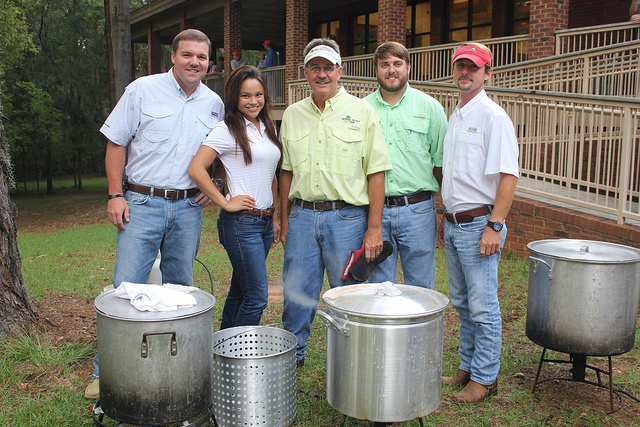 The Georgia Peanut Tour focuses on educating attendees about the quality of Georgia peanuts. However, the tour also promises to tout true Southern hospitality and great food while on the tour. This year is no exception! Tour attendees were treated to a reception sponsored by the American Peanut Shellers Association on Wednesday night and then a low-country boil sponsored by Dow AgroSciences. Marvin Stewart, regional sales rep. with Dow AgroSciences, has attended all 26 peanut tours and also cooked the low-country boil for every tour. At the end of the night Marvin and his team of Dow folks served ice cream and this year everyone has three different kinds to sample from including Reese’s Peanut Butter Cup, Chocolate with Peanut Butter swirls or Snickers ice cream. All three were fabulous and a great way to end the evening at Chehaw Educational Center.
The Georgia Peanut Tour focuses on educating attendees about the quality of Georgia peanuts. However, the tour also promises to tout true Southern hospitality and great food while on the tour. This year is no exception! Tour attendees were treated to a reception sponsored by the American Peanut Shellers Association on Wednesday night and then a low-country boil sponsored by Dow AgroSciences. Marvin Stewart, regional sales rep. with Dow AgroSciences, has attended all 26 peanut tours and also cooked the low-country boil for every tour. At the end of the night Marvin and his team of Dow folks served ice cream and this year everyone has three different kinds to sample from including Reese’s Peanut Butter Cup, Chocolate with Peanut Butter swirls or Snickers ice cream. All three were fabulous and a great way to end the evening at Chehaw Educational Center.
[polldaddy poll=6548883]
Keep the Aflatoxins out with JLA Global
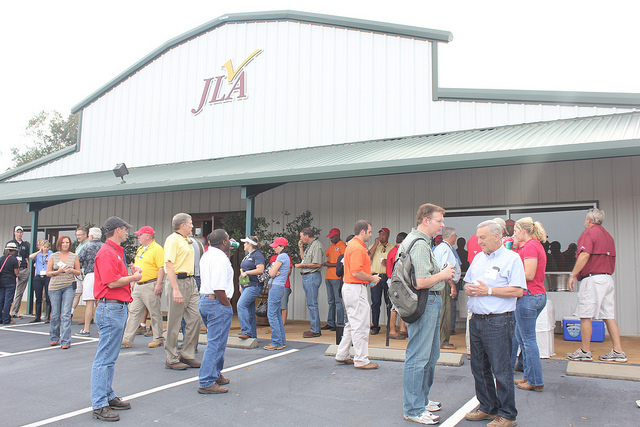 JLA Global is a peanut quality control testing corporation that has facilities all over the world. Today, the participants on the Georgia Peanut Tour visited the laboratory that is located in Albany, GA. The lab offers a variety of tests for many different diseases in multiple commodities. Participants learned specifically of disease testing in peanuts, mainly aflatoxin. The peanuts are sent from shellers and manufacturers to ensure their safety to see that the consumer receives the best product possible.
JLA Global is a peanut quality control testing corporation that has facilities all over the world. Today, the participants on the Georgia Peanut Tour visited the laboratory that is located in Albany, GA. The lab offers a variety of tests for many different diseases in multiple commodities. Participants learned specifically of disease testing in peanuts, mainly aflatoxin. The peanuts are sent from shellers and manufacturers to ensure their safety to see that the consumer receives the best product possible.
Dougherty County Ag Update
The Georgia Peanut Tour centered this year out of Albany, Ga. which is located in Dougherty County. The local Extension Coordinator, James Morgan, provided an update on agriculture in the area. He says the peanut crop in Dougherty County looks good to excellent this year. 85% of peanuts are irrigated and 15% non-irrigated, and the estimated peanut production in the county is 5,500-6,000lbs. Peanuts are one of the major crops grown in Dougherty County as well as pecans, corn, cotton, soybean and wheat. There have been some weather-related issues troubling some farmers such as white mold disease in some peanut fields, but, again, the peanut crop looks good. Other information Morgan included highlighted peanut-related industries such as Tara Foods, Mars Chocolate, Thrush Aircraft and more. Learn more about Dougherty County through the Extension Service office.
Peanut Breeding and Genetics at the Bolton Farm
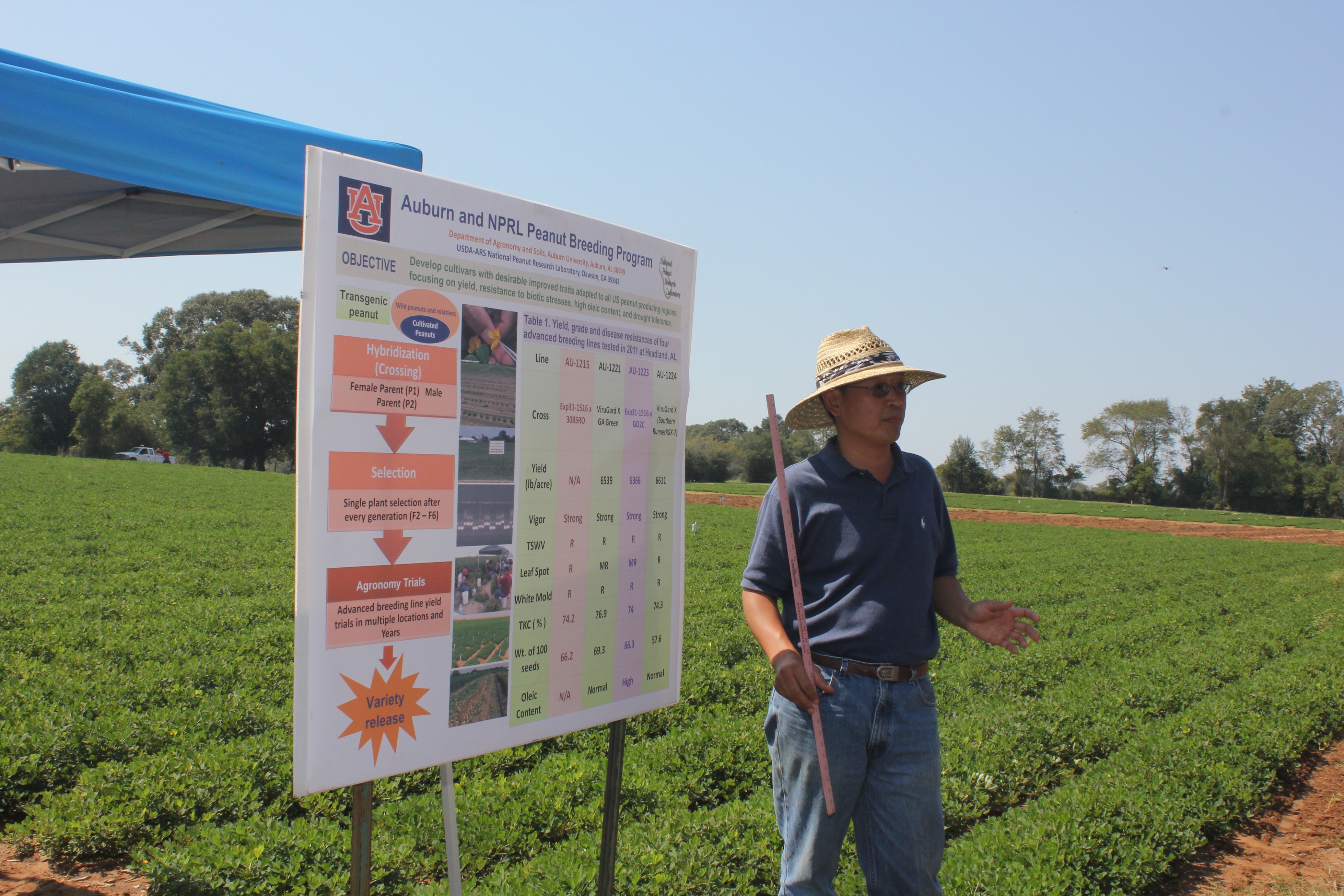 Charles Chen, Associate Professor and Geneticist/Peanut Breeder, shared information with tour attendees about a peanut breeding, genetics, and genome program conducted by Auburn University and the USDA-ARS National Peanut Research Laboratory that was established in 2007. The major objectives of the research are developing cultivators with desirable improved traits adapted to all U.S. peanut producing regions; and enhancing elite peanut germplasm through conventional and genomic approaches, and genetic transformation. The program focuses on high yield, resistance to tomato spotted wilt virus, leaf spot, maturity, and seed characteristics (size, split, taste et al.). High oil content, high oleic and low linoleic, and drought tolerance are also emphasized. The program goals are to understand the genetic principles of important agronomic traits in peanuts; to map quantitative trait loci (QTL) underlying the desired traits in peanuts; to explore genetic potential from genes to genomes for peanut improvement, and to discover new genes related to desirable agronomic and seed quality traits.
Charles Chen, Associate Professor and Geneticist/Peanut Breeder, shared information with tour attendees about a peanut breeding, genetics, and genome program conducted by Auburn University and the USDA-ARS National Peanut Research Laboratory that was established in 2007. The major objectives of the research are developing cultivators with desirable improved traits adapted to all U.S. peanut producing regions; and enhancing elite peanut germplasm through conventional and genomic approaches, and genetic transformation. The program focuses on high yield, resistance to tomato spotted wilt virus, leaf spot, maturity, and seed characteristics (size, split, taste et al.). High oil content, high oleic and low linoleic, and drought tolerance are also emphasized. The program goals are to understand the genetic principles of important agronomic traits in peanuts; to map quantitative trait loci (QTL) underlying the desired traits in peanuts; to explore genetic potential from genes to genomes for peanut improvement, and to discover new genes related to desirable agronomic and seed quality traits.
Peanut Research at NPRL’s Bolton Farm
Georgia Peanut Tour attendees were able to see first hand the ongoing research programs at the USDA/ARS National Peanut Research Lab’s Bolton Farm in Terrell County, Ga. NPRL conducts a variety of projects to assist the peanut industry focusing on environmental research, systems research, flavor/quality research, peanut grading research, storage research and mycotoxin research with particular emphasis on the aflatoxins. The Laboratory conducts research toward improving quality, cleaning, storing and marketing of peanuts. Research is oriented toward solving the major problems confronting the peanut producer, handler, manufacturer, and the consumer. NPRL is also intricately involved in studies toward developing new and improved production marketing systems to reduce unit cost, enhance domestic and foreign use of peanuts and provide a safe, high quality product to the consumer. The tour visited the Bolton Farm of NPRL and here’s a few highlights from the tour. . .
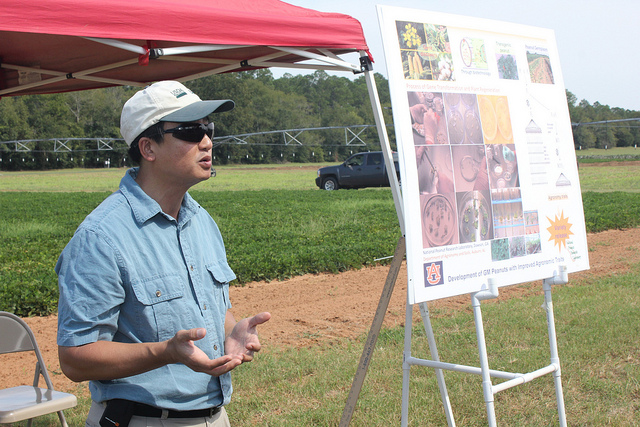 Phat Dang, Research Chemist
Phat Dang, Research Chemist
The process of regeneration and transformation allows us to transfer genes from different species that can confer either disease resistance or drought resistance that we couldn’t do through traditional breeding. We’ve identified that leaf spot is one of our initial targets that allows the combination of traditional breeding. Selecting varieties that already have higher levels of resistance but adding another gene to that will provide an even higher level of resistance . We are hoping that farmers can reduce their spray schedule and hopefully eliminate that spray schedule.
 Ron Sorenson, Research Agronomist
Ron Sorenson, Research Agronomist
The drip irrigation is very easy. Farmers can take normal drip irrigation they would use for vegetables and we bury it 2 to 3 inches in the ground and put in a main line. Bury so that it is alternate row middles and it costs about $300 per acre for the cost of tubing and main line. A farmer can irrigate and leave the drip tubing in the ground for about three years and use strip tillage and plant cotton, corn and peanut. When a farmer grows peanuts on the third year then they would remove the tubing prior to digging. So far, Sorenson has seen a 7 time yield increase for corn compared to dryland, a 3 times yield increase for cotton and 1 and a quarter times yield in increase for peanuts. However, he says a lot of that tends to deal with the way peanuts grow. He says they tend to hunker down with dry weather and sit and wait for the rain and then put on the yield when it rains.
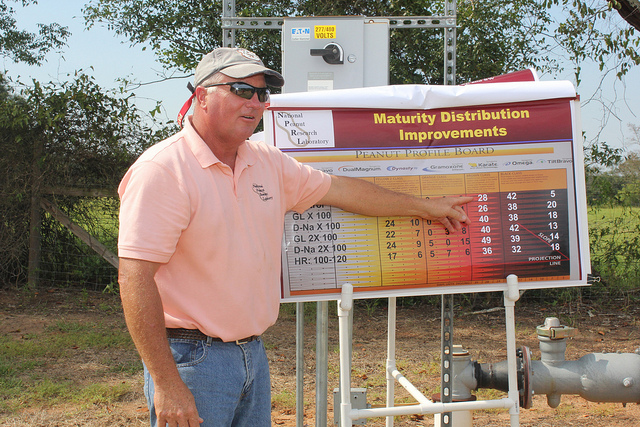 Marshall Lamb – NPRL Research Leader
Marshall Lamb – NPRL Research Leader
We’ve been looking at ways to improve the maturity distribution and the flavor of peanuts by reducing the amount of immature peanuts that come on the peanut plant as we are getting ready to harvest the most mature. The peanut being an indeterminate crop will basically bloom, flower and produce fruit until it dies. Sometimes that’s a good thing and sometimes that causes us problems because the immature peanuts can reduce grade and actually take energy away from those that are trying to become more mature and they also give us a lot of problems when we are drying and processing peanuts by mainly giving us an off flavor. We have found that with two chemical treatments we can break the flower cycle for about 20 days and that’s what we are after. With very little or minimal damage to the foliage. That did result when we did our maturity distributions in a lot more mature kernels on the peanuts compared to non-treated. If we have less immature peanuts and can take the energy and partition it to the more mature peanuts on the vine then hopefully that will improve yield and grade for the grower.
Terrell County Ag Update
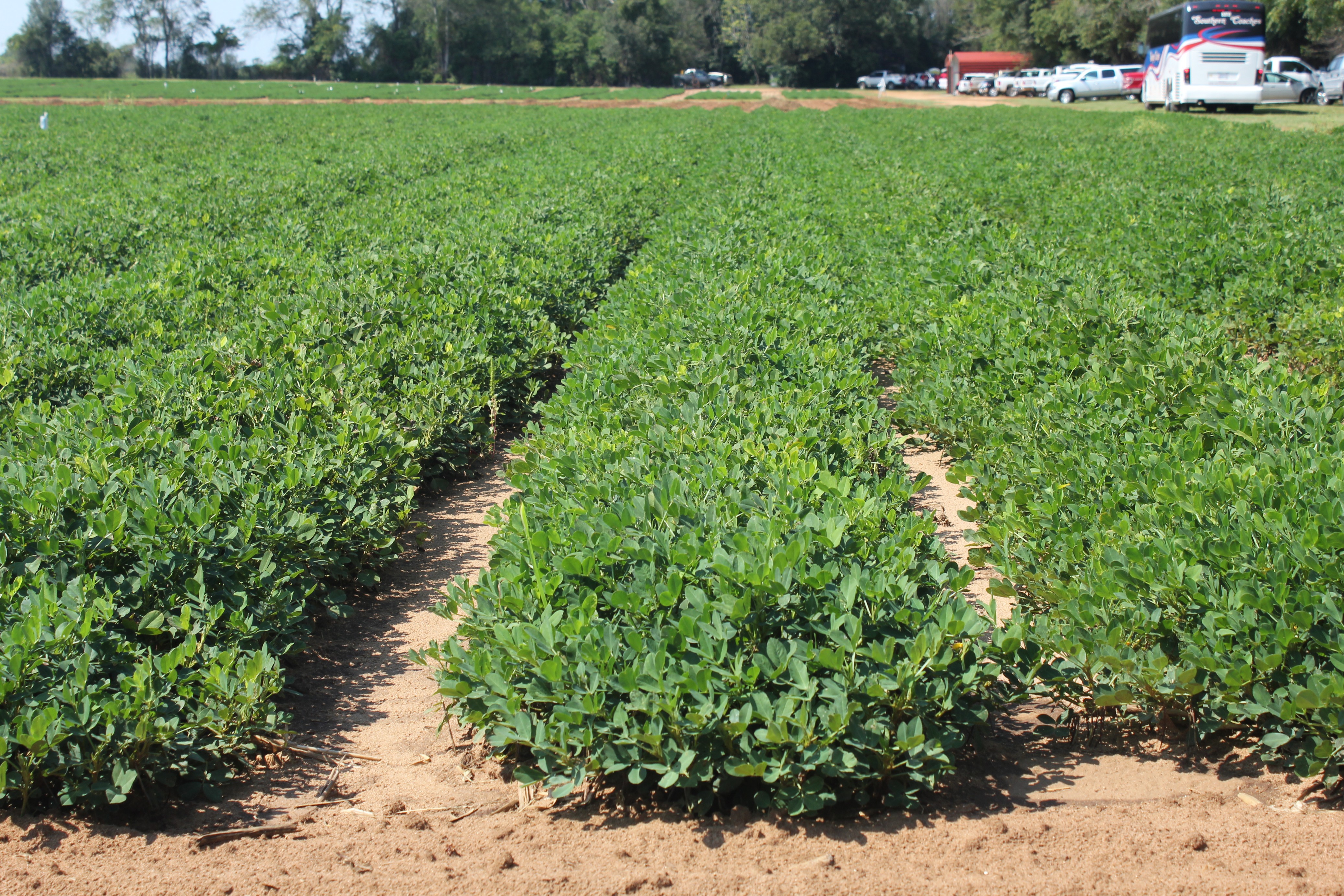 David Wagner, Terrell County Extension Agent, provided information regarding agriculture production in Terrell County. According to Wagner, agriculture is the largest industry in the state of Georgia and the number one industry in Terrell County. The economy of Terrell County rides on the back of agriculture, from the banker to the tire salesman, everyone is concerned with how the crops are doing. Peanuts have always been the centerpiece of Terrell County agriculture. The county’s infrastructure is centered around peanuts with the USDA National Peanut Lab located in Dawson. Also, Golden Peanut Company has a large presence in Terrell County both with buying peanuts and having a peanut crushing facility in Dawson. The Hooks-Hanner Environmental Resource Center is located in Terrell County studying agricultural water use.
David Wagner, Terrell County Extension Agent, provided information regarding agriculture production in Terrell County. According to Wagner, agriculture is the largest industry in the state of Georgia and the number one industry in Terrell County. The economy of Terrell County rides on the back of agriculture, from the banker to the tire salesman, everyone is concerned with how the crops are doing. Peanuts have always been the centerpiece of Terrell County agriculture. The county’s infrastructure is centered around peanuts with the USDA National Peanut Lab located in Dawson. Also, Golden Peanut Company has a large presence in Terrell County both with buying peanuts and having a peanut crushing facility in Dawson. The Hooks-Hanner Environmental Resource Center is located in Terrell County studying agricultural water use.
Peanuts, cotton, corn and wheat comprised most of the 62,000 acres planted to row crops in Terrell County this year. Peanut acreage went up with over 16,000 acres planted in the county this year. Almost 60% of the peanuts are irrigated, so 40% of the peanut crop suffered due to drought. The dry weather brought spider mites which defoliated many dryland fields early causing loss of pods and poor grades. The county had some rain this year and much more rain than last year, but many times during the growing season, Terrell would get several days of cloudy weather and high humidity with no rain. This only contributed to more plant disease and increased the cost of production with growers having to use more expensive fungicides to maintain plant health.
All things considered, the peanut crop looks pretty good at this time. If the crop can be harvested with no major losses due to weather or plant disease, Wagner is hopeful that over 26,000 tons of peanuts will be produced in Terrell County this year.
Fluffing peanuts at Neil Lee’s Farm
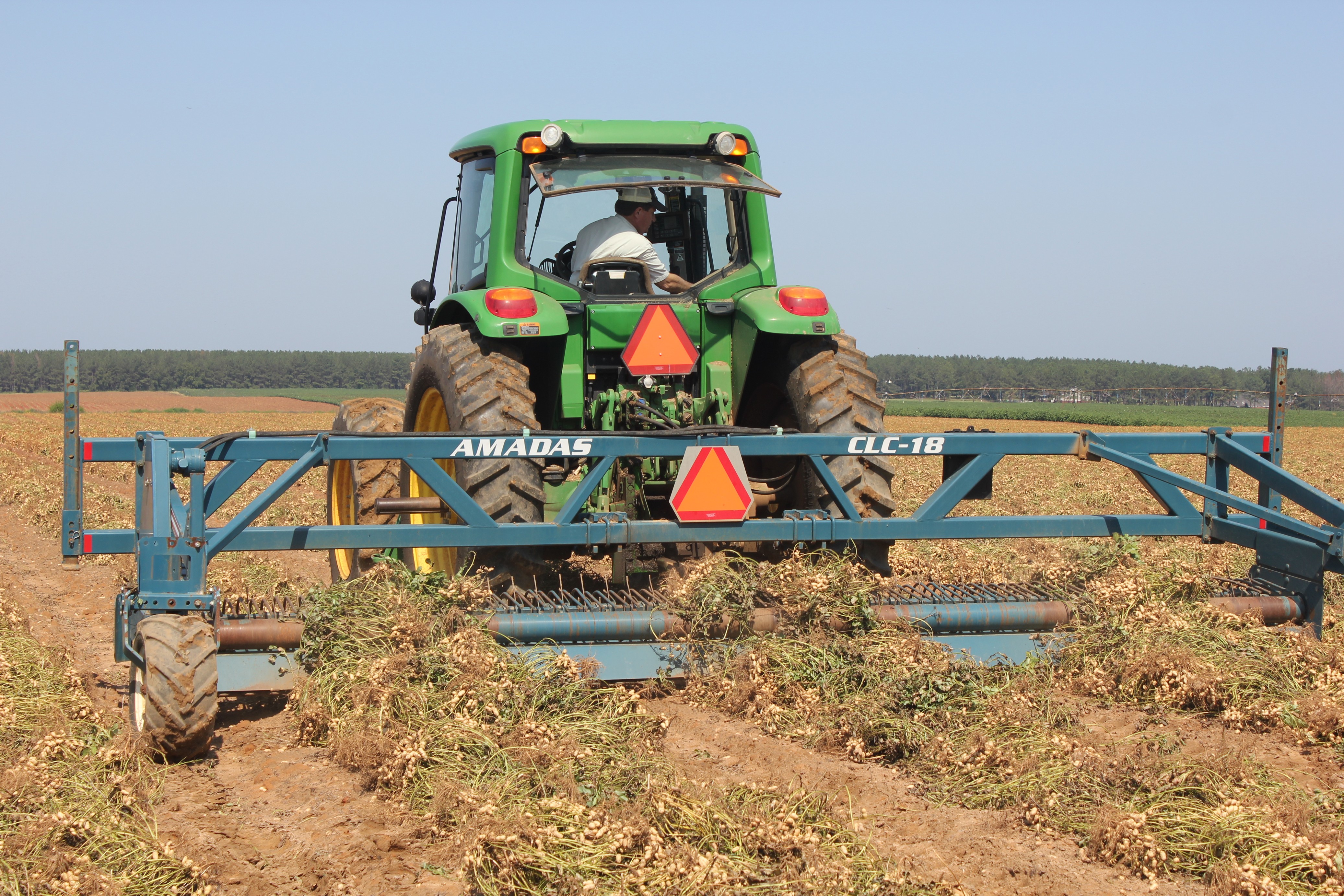 The second farm visit on the tour is at the home of Neil Lee from Bronwood, Ga. Neil farms with his dad and two brothers. The family farms as a partnership growing 7,000 acres of peanuts, cotton, corn and wheat. There are 1,200 acres of the farm planted in peanuts and some are irrigated while others are dryland peanuts. Neil grows Georgia 06-G peanut variety and has already picked all of the dryland peanuts which he says does not look that promising. During the 2012 season, Neil and his family struggled with the drought on their 150 acres of dryland peanuts like many farmers across the U.S. The Georgia Peanut Tour attendees visited an irrigated field Neil recently dug. Since digging the peanuts, it has rained in the area so he has to use a “fluffer” in the field prior to picking. The “fluffer” lifts the peanut vine so that air goes under the vine and helps dry them so that the vine is not sticking to the ground. Then the Lee family will be able to pick their peanuts and deliver them to the local buying point. The family also owns and operates a cotton gin, McCleskey Cotton, where they gin approximately 70,000 bales of cotton each year.
The second farm visit on the tour is at the home of Neil Lee from Bronwood, Ga. Neil farms with his dad and two brothers. The family farms as a partnership growing 7,000 acres of peanuts, cotton, corn and wheat. There are 1,200 acres of the farm planted in peanuts and some are irrigated while others are dryland peanuts. Neil grows Georgia 06-G peanut variety and has already picked all of the dryland peanuts which he says does not look that promising. During the 2012 season, Neil and his family struggled with the drought on their 150 acres of dryland peanuts like many farmers across the U.S. The Georgia Peanut Tour attendees visited an irrigated field Neil recently dug. Since digging the peanuts, it has rained in the area so he has to use a “fluffer” in the field prior to picking. The “fluffer” lifts the peanut vine so that air goes under the vine and helps dry them so that the vine is not sticking to the ground. Then the Lee family will be able to pick their peanuts and deliver them to the local buying point. The family also owns and operates a cotton gin, McCleskey Cotton, where they gin approximately 70,000 bales of cotton each year.
Lee County Ag Update
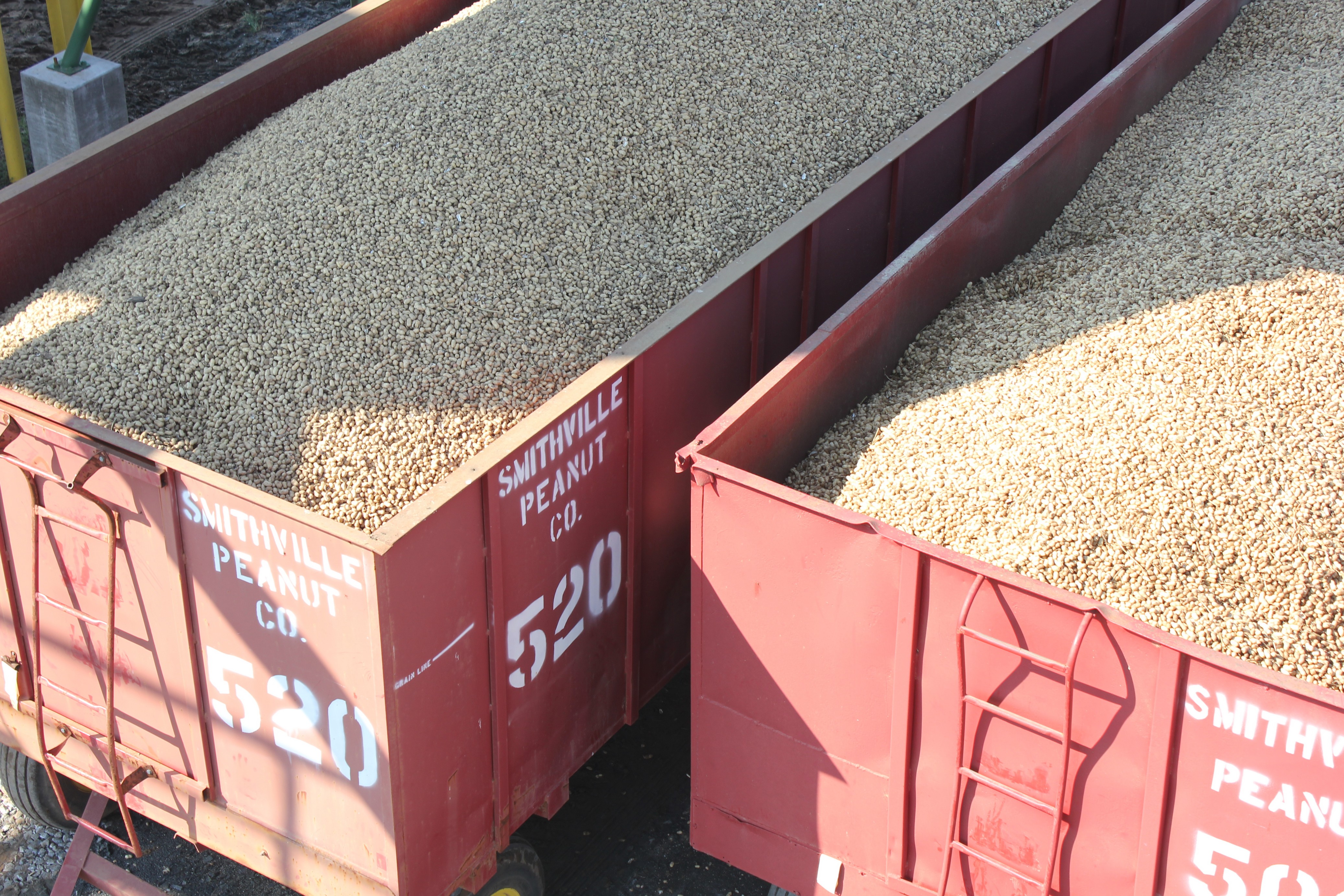 Lee County has several claims to fame including the famous baseball player Buster Posey and singers Luke Bryan and Phillip Phillips. However, Georgia Peanut Tour attendees were able to visit with area farmers and tour Smithville Peanut Buying Point, which is one of the three peanut buying points in the county. Lee County also is home to two peanut shelling plants. Doug Collins, Lee County Extension Coordinator, says the peanut crop looks very good for this growing season. The total peanut acreage in Lee County this year is 18,985 acres. Seventy percent of the peanut acreage is irrigated in the county. Collins expects that the average yield could approach two tons per acre this year. Peanuts were planted from very late March into June. Other major crops in Lee County include corn (10,350 acres), cotton (14,729.9 acres), wheat (7,464 acres), soybeans (3,208 acres), and pecans (7,112 acres). Rainfall amounts from place to place within the county have been very variable. In addition to Palmer amaranth, sicklepod was a troublesome weed this year. Lee County and neighboring counties of Dougherty & Mitchell also make up a fairly large percentage of Georgia’s pecan production.
Lee County has several claims to fame including the famous baseball player Buster Posey and singers Luke Bryan and Phillip Phillips. However, Georgia Peanut Tour attendees were able to visit with area farmers and tour Smithville Peanut Buying Point, which is one of the three peanut buying points in the county. Lee County also is home to two peanut shelling plants. Doug Collins, Lee County Extension Coordinator, says the peanut crop looks very good for this growing season. The total peanut acreage in Lee County this year is 18,985 acres. Seventy percent of the peanut acreage is irrigated in the county. Collins expects that the average yield could approach two tons per acre this year. Peanuts were planted from very late March into June. Other major crops in Lee County include corn (10,350 acres), cotton (14,729.9 acres), wheat (7,464 acres), soybeans (3,208 acres), and pecans (7,112 acres). Rainfall amounts from place to place within the county have been very variable. In addition to Palmer amaranth, sicklepod was a troublesome weed this year. Lee County and neighboring counties of Dougherty & Mitchell also make up a fairly large percentage of Georgia’s pecan production.
Sumter County Ag Update
Sumter County Extension Coordinator, Bill Starr, updated the Georgia Peanut Tour group on the peanut crop in Sumter County. The county is unique in that most of the peanuts are grown for seed. Farmers in Sumter County planted 10,000 acres of peanuts this year with an estimate of around 3800 pounds average per acre. Approximately 75% are irrigated and Starr says that the overall peanut crop looks really good although farmers have faced troublesome productions issues this year with white mold and pigweeds. Other crops grown in the county are cotton, corn, and green beans. In fact, Sumter County is the Green Bean Capital of Georgia, with approximately 2,000 acres of green beans or snap beans grown.
